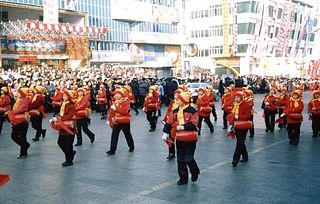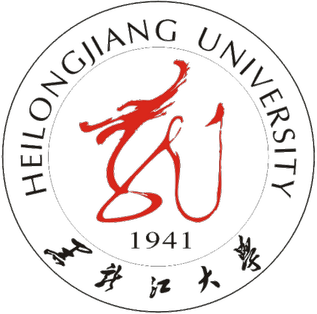
Harbin is a sub-provincial city and the provincial capital and the largest city of Heilongjiang province, People's Republic of China, as well as the second largest city by urban population after Shenyang and largest city by metropolitan population in Northeast China. Harbin has direct jurisdiction over nine metropolitan districts, two county-level cities and seven counties, and is the eighth most populous Chinese city according to the 2020 census. The built-up area of Harbin had 5,841,929 inhabitants, while the total metropolitan population was up to 10,009,854, making it one of the 100 largest urban areas in the world.

Heilongjiang is a province in northeast China. The standard one-character abbreviation for the province is 黑. It is the northernmost and easternmost province of the country and contains China's northernmost point and easternmost point.

Shuangyashan is a coal mining prefecture-level city located in the eastern part Heilongjiang province, People's Republic of China, bordering Russia's Khabarovsk and Primorsky Krais to the east. The city's name means a pair-of-ducks mountains and refers to two peaks northeast of the city. In 2007 the city had a GDP of RMB 20.6 billion with a 14.2% growth rate.

Qiqihar is the second-largest city in the Heilongjiang province of China, in the west central part of the province. The built-up area made up of Longsha, Tiefeng and Jianhua districts had 959,787 inhabitants, while the total population of the prefecture-level city was shrinking to 4,067,489 as of the 2020 census. These are mainly Han Chinese, though the city is also home to thirty-four minorities including Manchus, Daur, and Mongols.

Mudanjiang, alternately romanized as Mutankiang, is a prefecture-level city in the southeast part of Heilongjiang province, People's Republic of China. It was called Botankou under Japanese occupation. It serves as a regional transport hub with a railway junction and an international airport connecting with several major Chinese cities as well as Incheon International Airport serving Seoul. Mudanjiang is located 248 km (154 mi) from Vladivostok, Russia. In 2011, Mudanjiang had a GDP of RMB 93.48 billion with a 15.1% growth rate. In 2015, Mudanjiang had a GDP of RMB 118.63 billion.

Suihua is a prefecture-level city in west-central Heilongjiang province, People's Republic of China, adjacent to Yichun to the east, Harbin, the provincial capital, to the south, Daqing to the west and Heihe to the north. It has 3,756,167 inhabitants at the 2020 census, of whom 698,025 lived in the built-up area made of Beilin District.

Acheng District is one of nine districts of the prefecture-level city of Harbin, the capital of Heilongjiang Province, Northeast China, covering part of the southeastern suburbs. The district was approved to establish from the former Acheng City (阿城市) by the Chinese State Council on August 15, 2006. As of 2010, it had a population of 596,856 residing in an area of 2,680 km2 (1,030 sq mi), and is 29 km (18 mi) southeast of downtown Harbin, 190 km (120 mi) north of Jilin City, and around 50 km (31 mi) south of the Songhua River. It lies within the basin of and until 1909 was considered synonymous with the Ashi River which gave its name to the Jurchen Jin Dynasty. The district administers nine subdistricts, eight towns, one township, and one ethnic township. It borders Daowai District to the north, Bin County to the northeast, Shangzhi to the southeast, and Wuchang to the south, Shuangcheng District to the west, and Pingfang and Xiangfang Districts to the northwest.

The Jilin chemical plant explosions were a series of explosions which occurred on November 13, 2005, in the No.102 Petrochemical Plant in Jilin City, Jilin Province, China, over the period of an hour. The explosions killed six, injured dozens, and caused the evacuation of tens of thousands of residents.

Harbin Normal University (HNU) is a university located in Harbin, Heilongjiang province.

Nangang District is one of nine districts of the prefecture-level city of Harbin, the capital of Heilongjiang Province, Northeast China, forming part of the city's urban core. It is home to major offices of the provincial government and is the political heart of Heilongjiang province. Other areas of interest within the district are the Harbin Railway Station, Guomao underground shopping street, a Confucian temple and the Buddhist Jile Temple. By far the most populous and densely populated of Harbin's county-level divisions, it borders the districts of Daowai and Xiangfang to the northeast, Pingfang to the southeast, Shuangcheng to the south, and Daoli to the west. A new subway system is also being built currently.

Long Guang, which stands for Dragon Broadcast, is the radio station group that was once the Harbin Ren Min Guangbo Dian Tai, translated as Heilongjiang People's Broadcasting Station, which consists of several radio stations broadcasting from Harbin and the greater Heilongjiang Province area..

Dragon Tower, also known as Long Ta or Heilongjiang Tower, is a 336 m (1,102 ft) tall multi-purpose Chinese steel lattice television and observation tower. The Long Ta is used for television broadcasting; telecommunication, transmitting FM-/TV-broadcasting throughout the province of Heilongjiang; for observation, providing a view of the surrounding areas of city. The tower has observation decks and buffet restaurants. It has a AAAA rating.

Harbin University of Science and Technology is a university in Harbin, China. Previously known as Harbin University of Science and Technology. It is colloquially known as Hakeda, or Harbin Institute of Electrical Technology(Chinese: 哈尔滨电工学院; pinyin: Hā'ěrbīn Diàn'gōng Xuèyuàn). It is colloquially known as Hadiangong.
Jiang Daming is a politician of the People's Republic of China. He served as the Minister of Land and Resources, and formerly served as Governor of Shandong province.
Harbin is the capital and largest city of Heilongjiang province, People's Republic of China.

Harbin Medical University (HMU) (Chinese: 哈尔滨医科大学) is a public university located in Harbin, Heilongjiang, China.

The G1011 Harbin–Tongjiang Expressway, commonly referred to as the Hatong Expressway, is an expressway that connects the cities of Harbin, Heilongjiang, China, and Tongjiang, a county-level city in Jiamusi, Heilongjiang. It is completely in Heilongjiang Province.

University of Heilongjiang is a national university in the city of Harbin, Heilongjiang Province, People's Republic of China.

The Heilongjiang hand cannon or hand-gun is a bronze hand cannon manufactured no later than 1288 and is the world's oldest confirmed surviving firearm. It weighs 3.55 kg and is 34 centimeters long. The Heilongjiang hand cannon was excavated during the 1970s in Banlachengzi, a village in Acheng District, Heilongjiang province, China. It was found alongside other bronze artifacts made in the style of the Jurchen Jin Dynasty. The hand cannon was probably used in battles fought nearby in Banlachengzi in 1287 and 1288. The History of Yuan states that a Jurchen commander by the name of Li Ting led a group of soldiers equipped with hand cannons into a military camp in 1288, as part of an anti-rebellion campaign for the Yuan dynasty. The cannon currently resides at the Heilongjiang Provincial Museum in Harbin, China.

Heilongjiang Provincial Library is the largest library in Heilongjiang Province, as well as a major provincial library in China. It houses important scientific, cultural and arts literature relating to Northeast China and other national historical records such as ancient Chinese and foreign publications.

















